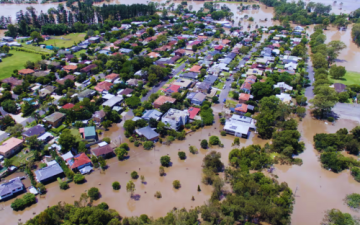Descartes Underwriting’s Head of Southeast Asia, Robert Drysdale, sat down to share his insights on current insurance market conditions across the region. As climate volatility continues to evolve, the region continues to experience Nat Cat risks, inevitably having a direct toll on the insurance industry. Industries like the renewable sector, tourism and manufacturing are starting to go parametric to cope with the mounting pressure. Read on to hear from Robert on how parametric insurance provides a great risk alternative for industries across Southeast Asia facing the full brunt of climate risks amidst a challenging insurance market context.
How would you describe current insurance market conditions across Southeast Asia?
Robert: Similar to the rest of the world, we are continuing to see hardening market conditions across most of the markets in Southeast Asia.
However, except for specific instances, such as flood in Australia, we are observing different Nat Cat capacity crunches in this region compared to others. Conversations around Nat Cat cover still focus on pricing rather than a genuine lack of available capacity in the traditional insurance market. However, there is a growing expectation that this may change in some territories later in the year.
Where are you seeing demand for parametric nat cat insurance solutions?
Robert: Our products apply to many different industries and lines of business, as parametric insurance is much less concerned about the asset type itself. When structuring parametric covers, the clients’ exposure to Nat Cat and/or extreme weather perils is more critical.
In Southeast Asia, we currently see the most traction in: Renewable Energy, Agriculture, Manufacturing and the Tourism or Hospitality industries. This is because these sectors have the largest protection gaps from the traditional insurance offering.
These gaps can take the form of higher retentions, reduced cover, and higher premium rates, especially if they have suffered a recent loss event. Combined or replacing SIRs, parametric insurance can help plug these gaps in coverage and reduce the clients’ premium spend.
As we enter a post-covid world, how are Renewable Energy, Agriculture, Manufacturing, the Tourism or Hospitality industries adapting to changes?
Robert: We are certainly seeing concern from some clients about their supply chains and supply chain management. This has led to an increase in the number of inquiries we receive from brokers about how parametric insurance can protect clients from non-damage business interruption exposures linked to their supply chains.
Renewable energy projects and carbon credit markets are also continuing to be hot topics, particularly with growing awareness of climate change. These are areas where parametric products can help support development, financing and lender requirements.
With the removal of Covid travel restrictions and social distancing measures, we are also seeing a return to somewhat normality for tourists. Tourism is a crucial source of GDP for many countries in this region.
Beachfront hotels and commercial properties with high Nat Cat exposure struggle to find adequate cover in the traditional market. Parametric cover can be an excellent way for them to obtain the Nat Cat protection they require.
How can parametric insurance meet the demands of areas with such high climate risk exposures?
Robert: The coverage provided by parametric insurance can be more comprehensive than what’s currently available in the traditional insurance market. Due to how the cover works, there’s no need for deductibles, sub-limits, or exclusions. The cover also extends to non-damage business interruption exposures, which can often be left out of traditional indemnity policies.
Parametric insurance is also based on clear indexes rather than lengthy clauses. It’s very transparent and can be paid quickly once certain parameters are triggered. For instance, we can link pay-outs to the wind speed of tropical cyclones at specific locations so that clients are paid in the days following such events. Typically we can make claim payments within a few weeks at most, whereas it is not uncommon for similar payments in the traditional market to take over a year.
We can also design similar indexes for other natural catastrophes and extreme weather risks, such as earthquakes, excess rainfall & flood, drought, hailstorms, and wildfires.
Explore Parametric Water Scarcity Insurance for Agribusinesses
As Southeast Asia moves away from burning fossil fuels toward cleaner renewable energy sources, what are the ways in which parametric insurance can help clients with this transition?
Robert: We have many different parametric products for Renewable Energy, which can be used to cover other exposures throughout the entire project lifecycle – from financing through operations.
For instance, we have found that even during the project funding phase, some lenders are very keen for operators of new wind farms to consider buying protection against poor wind conditions, which would affect revenue and, ultimately, their ability to repay the loans. This is an exposure that can be covered with parametric insurance.
During the construction, transportation and installation phase, we see demand for Nat Cat covers, particularly tropical cyclone, earthquake, and hail for solar farm projects. There is also demand for our adverse-weather construction delay products, which offer protection against non-damage business interruption (or delay in startup). Exposures such as excess rainfall, extreme heat or high wave height, which cause unexpected delays to projects and are generally uninsured by the traditional market.
Finally, we have also had success during the operational phase with our Nat Cat and renewable energy yield products, such as lack of wind or water resources for wind farms or hydroelectric power stations.
What does the future of parametric insurance look like in the next 5-10 years?
Robert: Parametric insurance is highly niche in the region and is still in the early stages of market development. To develop the market, more is needed in the short term to spread awareness and education about the products and how they can be used effectively in combination with traditional programs. However,Southeast Asia is one of the most climate-risk-exposed regions in the world, so there is some urgency and a need for parametric insurance to complement or replace traditional cover in order to help prevent the widening protection gap.
Parametric insurance products also lend themselves well to crucial regional strategic industries and emerging markets, such as carbon credits. With Southeast Asia projecting solid economic growth and renewable energy investment in the coming years, all these factors should translate into a more mature marketplace for parametric insurance in the next 5 – 10 years.



